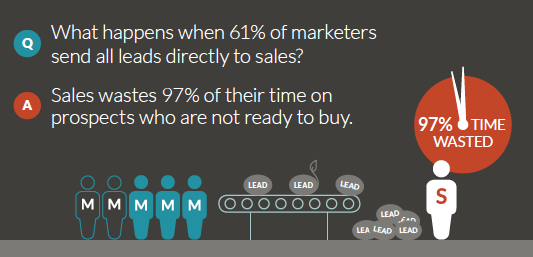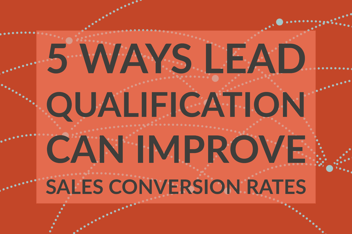How To Qualify Leads Before Turning Them Over To Sales [free checklist template]
If we asked your sales team today where their best leads come from, what would they say?
Based on past surveys of marketing and sales pros, it’s likely that they would say their best leads are the ones sourced by the sales department, followed by referrals, and then, at the bottom, leads that come from marketing. Ouch.
How can you change that perception? Two words: lead qualification.
Rather than just sending every marketing- or inbound-generated lead straight to sales, where they end up wasting up to 97 percent of their time on leads that will never buy, marketing needs to step up and implement processes to qualify leads based on five different criteria.
(See those stats and more in this State of Inbound Report.)

The criteria you should use to identify marketing-qualified leads before sending them to sales are:
- Need
- Fit
- Budget
- Influence
- Timeline
When your marketing and sales department work together to establish the lead qualification criteria needed to hand off the best possible leads, your sales staff can focus on leads who are ready to buy—preferably from you.
By using closed-loop marketing and an automated lead nurturing system that tracks how visitors and leads interact with your website, you can learn a lot about leads even before making a personal connection. What you learn can help you decide if the leads should be sent into the sales pipeline.
But first, you will need to reach an agreement about what defines a qualified lead. Our Lead Qualification Checklist will help your teams develop that definition and use it to weed out leads that are unlikely to develop into sales.
(Developing a positive working relationship between marketing and sales is always important, but often challenging. Learn more in our ebook on the topic: The Complete Guide To Unifying Marketing & Sales.)
Now, let’s walk through the five criteria you need to define:
1. Need.
This may seem obvious, but if you are using inbound marketing, there is a good chance your content will be attracting contacts (aka leads) who don’t actually need your products or services—they are just there for the content. If you are generating high quality content, you may be drawing in readers who are researching for other reasons, but have found your content to be reliable.
For example, a researcher in a related field may be downloading your report to see how your data could be useful for their work, but they aren’t really looking for your services. Your content could also be downloaded at times by competitors, students, or just casual hobbyists with an interest in your field. None of these leads have a need for your product or service, so they would not meet this lead qualification criteria.
However, if a lead does have a need for your product or service, you may be able to use clues from their interaction with your site to begin building a file of lead intelligence that will help sales make a connection. Tracking tokens can tell you what pages they visited, as well as which offers they downloaded, and even what terms they searched that brought them to your site. Take note of those to pass along so that your sales team has an idea of what problems this lead needs to solve.
2. Right fit.
Once you’ve identified if the lead has a need, then you need to determine whether you have a product or service that can fit that need. Is your solution the right size for what this lead needs?
This could mean that you eliminate some leads who have a need for a solution similar to what you offer, but whose size doesn’t fit. That could because your company focuses on enterprise level B2B customers, and isn’t set up to service a lot of small customers, or it could be that the lead’s challenge is beyond your scope of ability to solve.
If it does seem that the lead’s problem and your solution are a good fit, before declaring a marketing qualified lead, again use the data your system has collected to determine what product or service that you offer is the right one for sales to start their discussions with.

3. Budget.
Similar to the discussion above, identify whether the prospect has the budget needed to invest in your solution. There is no reason for sales to enter into discussions with a lead if it is obvious that the lead doesn’t have the necessary budget for your product or services.
Having some indication of the budget available before beginning discussions can also help sales position solutions accordingly, with room for negotiation, but without scaring away a lead by starting the discussion well beyond their budget availability.

4. Influence level.
Your inbound marketing content will likely attract leads from a variety of levels within a company—from CEOs to the end users of your solution. Not all of these leads are in a position to make a purchase decision. It is important to know if a lead is a decision maker, or if they don’t have authority to make a decision, but can influence the decision-making process.
You have probably already identified multiple customer personas with varying levels of influence on purchase decisions and created content for each. Each will need a different approach from both marketing and sales. If the lead is the end user of a product—for example, an accounting software system—your marketing content and sales approach may emphasize ease of use, but also provide them with the bottom line ROI information that the executive suite will need in order to be convinced to use your solution.

5. Timeline.
It is important to have a solid understanding of a lead’s timeline and urgency as you hand them off to sales. This includes knowing both the length of a typical sales cycle for this type of customers (For example: Do they have to wait for a quarterly board meeting to make a final decision?) and the specific timeline of this customer (Are they currently in a contract for service that won’t expire for another year? Do they need something in place in the next month to replace a lost vendor?).
Answers to these questions will help the sales team determine what approach to take, whether to give the lead some space and time or get a lot of information to them quickly to make a decision under a tight deadline.
By working together to align your marketing and sales departments, including reaching a shared definition of what constitutes a qualified lead, your marketing team can become a trusted source of leads by only sending sales the most promising prospects and weeding out those contacts that are not going to develop into deals. Our Lead Qualification Checklist template can be used either to guide that discussion or as a way to pass along information on individual leads, with details about each of the criteria for that lead in a PDF form.
Other reading and resources on lead qualification and marketing-sales alignment:
- The Complete Guide To Unifying Marketing & Sales
- The Intersection of Marketing-Sales Alignment & Marketing Effectiveness
- Are Your Sales & Marketing Departments Communicating?
- Rate Your Marketing-Sales Relationship (quiz)
- 5 Ways Lead Qualification Can Improve Sales Conversion Rates
- Defining Lead Status: Cool, Warm Or Hot
-1.png?width=1652&height=294&name=Jones(RGB)-1.png)














